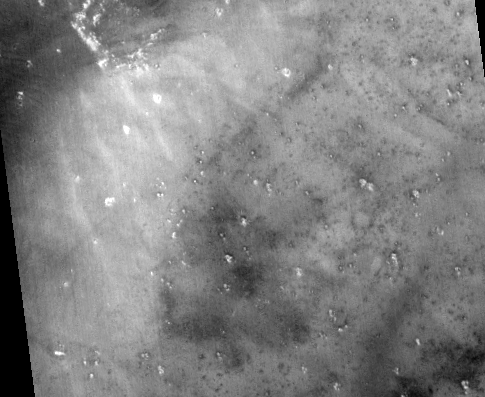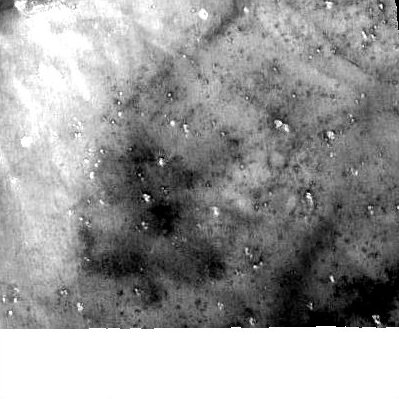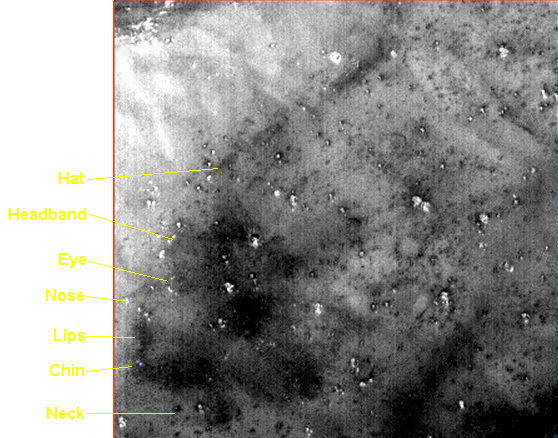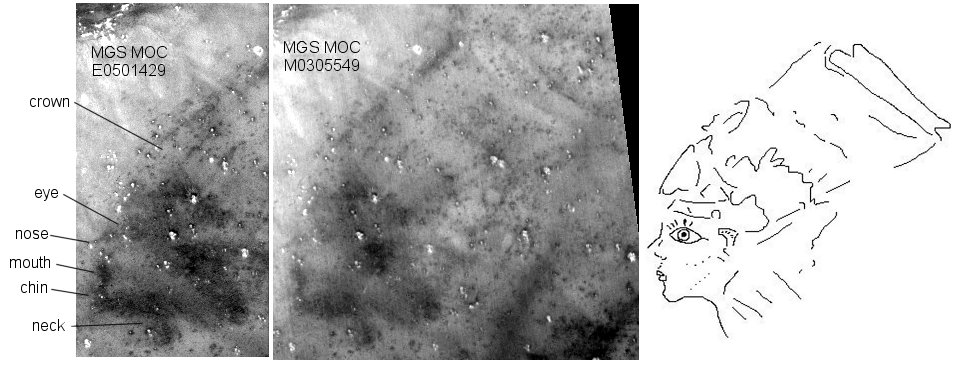 MGS Image # M0305549 Access the MOC images and ancillary data at http://www.msss.com/moc_gallery/ab1_m04/images/M0305549.html Image courtesy of NASA/JPL/MSSS The above image was cropped directly from the image provided by Malin Space Science Systems. The contrast was increased slightly. The image below has been contrast enhanced. At Phoenicis Lacus, dark areas on the surface of the planet form a convincing face in profile with eye, nose, nostril, lips, chin, neck, and a very large hat with a headband. |

|

|
The eye is especially compelling in that all the important parts of a human eye are present: a pointed lid aperture, light colored sclera (white of the eye), cheekbone, round iris, and pupil. Lashes appear to be laden as if with makeup.
Note the shading around the cheek, chin, and jaw. Shading also gives the impression of a neck tendon.
It is possible this feature has been misnamed... is this face bearded?
The NASA/JPL/MSSS image was taken by the Mars Global Surveyer Mars Orbital Camera (MGS MOC) from an altitude of 375.84 km, at longitude 108.12W, latitude 14.05S, and has a resolution of 5.65 meter pixel width.
Given the MSSS image width of 2.89 km, the dimensions of the face-like feature can be estimated: the eye is about 140 meters across, the face is about 780 meters from the tip of nose to the back of the head, and the hat is 1.3 km long.

One cannot help but be reminded of Egyptian art because of the long Nefertiti-like hat. Similarities with the unfinished plaster bust of Nefertiti from Amarna, now in Berlin, are obvious.

As if to mimic Eqyptian art, the entire eye is visible even though the face-like feature is in profile. Note how the eye in the 3-d bust of Nefertiti is in correct perspective while other Egyptian art, drawn on flat tomb walls, almost always depicts the entire eye, including the nasal point of the lid aperture.

A second image of the area was acquired months later during the MGS Extended Mission phase, MGS E0501429, proving the impression of the face is not an imaging artifact or fluke of shadows, but that the colorations do indeed exist on the surface.
Many have argued that the anomalous faces and other objects found on Mars are "tricks of light and shadow" and that under different camera and lighting conditions the "illusion" goes away. It is indeed true that apparent face-like figures are made this way, but with a feature such as the above 'Queen', the shadow argument is irrelevant because the feature is not composed of raised areas casting shadows, but of dark colorations on a flat surface. There are no shadows creating the image of this face. Also, different lighting and camera angles would not appreciably alter the image in any unpredictable way and as long as there is enough light to see, certainly would not make it go away completely.
"Differential erosion" is also a favorite explanation used by the skeptic. Once again this excuse is irrelevant here. A flat "picture", erosional forces are not involved.
"Flat art", especially strong examples such as this which display astonishing facial detail, are very difficult to explain away as illusions or formed by natural processes. Might not the Artificial Origins Hypothesis have merit here?
 Home
Home
 Links
Links
 About Us
About Us
